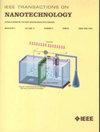用于卷积神经网络加速器的随机-二进制混合空间编码乘法器
IF 2.1
4区 工程技术
Q3 ENGINEERING, ELECTRICAL & ELECTRONIC
引用次数: 0
摘要
卷积神经网络在人工智能领域有着卓越的性能,但其代价是单个推理过程的计算量巨大。与此同时,随着摩尔定律的减弱,底层芯片工艺也达到了极限。随机计算作为一种对硬件友好的非常规方法,可以减轻电路级复杂运算的负担。本研究提出了一种新颖的随机计算(SC)乘法器,它采用了一种扩展均匀的方法来创建位序列,而无需依赖逻辑门。此外,我们还提出了一种随机二进制域算术方法,以实现低成本硬件实现和低功耗耗散。4n 位宽度被划分为 n 个 4 位宽度,高精度部分在二进制域中执行,低精度部分在随机域中执行。此外,还引入了用于补偿故障的硬件兼容电路。在 cifar10 上使用随机二进制混合域空间编码(SHSC)乘法器的加速器比对应的定点乘法器性能更好,面积减少了 33.7%,功耗降低了 23%。本文章由计算机程序翻译,如有差异,请以英文原文为准。
Stochastic-Binary Hybrid Spatial Coding Multiplier for Convolutional Neural Network Accelerator
Convolutional neural networks have remarkable performance in artificial intelligence, although at the cost of computationally demanding processes within a single inference. Simultaneously, the underlying chip process is reaching its constraints as Moore's law diminishes. Stochastic computation, as a hardware-friendly and unconventional approach, can alleviate the burden of sophisticated arithmetic at the circuit level. This work presents a novel stochastic computing (SC) multiplier that employs an extension-uniform approach to create bit sequences without relying on logical gates. In addition, we propose a stochastic-binary domain arithmetic method to achieve low-cost hardware implementation and low power dissipation. The 4n-bit widths are partitioned into n 4-bit widths, with the high-precision components executed in the binary domain and the low-precision components executed in the stochastic domain. Additionally, a hardware-compatible circuit for compensating faults is also introduced. The accelerator on cifar10 using stochastic binary hybrid domain spatial coding (SHSC) multiplier achieves better performance than the fixed-point counterpart, with a 33.7% reduction in area and 23% reduction in power.
求助全文
通过发布文献求助,成功后即可免费获取论文全文。
去求助
来源期刊

IEEE Transactions on Nanotechnology
工程技术-材料科学:综合
CiteScore
4.80
自引率
8.30%
发文量
74
审稿时长
8.3 months
期刊介绍:
The IEEE Transactions on Nanotechnology is devoted to the publication of manuscripts of archival value in the general area of nanotechnology, which is rapidly emerging as one of the fastest growing and most promising new technological developments for the next generation and beyond.
 求助内容:
求助内容: 应助结果提醒方式:
应助结果提醒方式:


